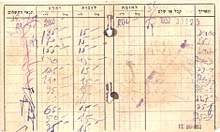Israeli pound
| Israeli pound | |
|---|---|
|
לירה ישראלית (in Hebrew) ليرة إسرائيلية (in Arabic) | |
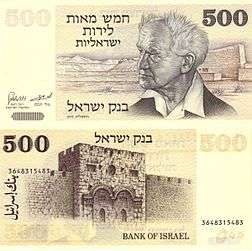 I£500 note (observe and reverse) issued in 1975 | |
| ISO 4217 | |
| Code | ILP |
| Denominations | |
| Subunit | |
| 1/1000 |
mil (1951–1952) pruta (1952–1960) |
| 1/100 | agora (1960–1980) |
| Plural | pounds (לירות lirot) |
| mil (1951–1952) pruta (1952–1960) | prutot (פרוטות) |
| agora (1960–1980) | agorot (אגורות) |
| Symbol | ל"י or I£ |
| Banknotes | I£5, I£10, I£50, I£100, I£500 |
| Coins | 1, 5, 10, 25 agorot, I£1/2, I£1, I£5 |
| Demographics | |
| User(s) |
|
| Issuance | |
| Central bank |
Bank Leumi (1952–1955) Bank of Israel (1955–1980) |
| Valuation | |
| Pegged with | British pounds (1952–1954) |
| Pegged by | I£1:£1 |
|
This infobox shows the latest status before this currency was rendered obsolete. | |
The Israeli pound (Hebrew: לירה ישראלית Lira Yisr'elit, Arabic: ليرة إسرائيلية) or Israeli lira was the currency of the State of Israel from 9 June 1952 until 23 February 1980, when it was replaced with the shekel on 24 February 1980, which was again replaced with the New Shekel in 1985.
Until 1952, the name used on the notes of the Anglo-Palestine Bank was Palestine pound, in Hebrew לירה א"י (lira E.Y. i.e. lira Eretz-Yisraelit). In Arabic, the name was given as junayh filisţīnī (جنيه فلسطيني).[1]
On 1 May 1951, all the assets and liabilities of the Anglo Palestine Bank were transferred to a new company called Bank Leumi Le-Yisrael (Israel National Bank) and the currency name became: lira yisraelit (לירה ישראלית) in Hebrew, junayh isrāīlī in Arabic, and Israel pound in English.[2] The new currency was issued in 1952, and entered circulation on June 9. From 1955, after the Bank of Israel was established and took over the duty of issuing banknotes, only the Hebrew name was used, along with the symbol "I£".[3]
History
The British Mandate of Palestine, which administered the territory now known as Israel, Jerusalem, the West Bank and Gaza prior to May 15, 1948, issued the Palestine pound, a currency equal in value and pegged to the British pound, which was divided into 1000 mils. Banknotes in circulation were issued by the Palestine Currency Board, which was subject to the British Secretary of State for the Colonies.
Israel inherited the Palestine pound, but shortly after the establishment of the state, new banknotes were issued by the London-based Anglo-Palestine bank of the Zionist movement. The new coins were the first to bear the new state's name, and the banknotes had "The Anglo-Palestine Bank Limited" written on them. While the first coins minted by Israel still bore the name "mil", the next ones bore the Hebrew name prutah (Hebrew: פרוטה). A second series of banknotes was issued after the Anglo-Palestine Bank moved its headquarters to Tel Aviv and became the Bank Leumi (Hebrew: בנק לאומי "National Bank"). The pegging to the UK Pound was abolished on January 1, 1954, and in 1960, the subdivision of the pound was changed from 1000 prutot to 100 agorot (singular agora, Hebrew: אגורה ,אגורות).
During the 1960s, a debate over the non-Hebrew name of the Israeli currency resulted in a law ordering the Minister of Finance to change the name pound into a Hebrew name, shekel (שקל). The law allowed the minister to decide on a proper date for the change. The law did not come into effect until February 1980, when the Israeli government decided to change the monetary system and introduce the Israeli old shekel, at a rate of 1 shekel = 10 pounds.
Coins
Israel's first coins were aluminium 25 mil pieces, dated 1948 and 1949, which were issued in 1949 before the adoption of the pruta. Later in 1949, coins were issued in denominations of 1, 5, 10, 25, 50, 100 and 250 prutah. The coins were conceived, in part, by Israeli graphic designer Otte Wallish.
All coins and banknotes issued in Israel before June 1952 were part of the Palestine pound.
In 1960, coins were issued denominated in agora. There were 1, 5, 10 and 25 agorot pieces. In 1963, 1/2 and 1 pound coins were introduced, followed by 5 lirot coins in 1978.
Banknotes
In 1948, the government issued fractional notes for 50 and 100 mils. The Anglo-Palestine Bank issued banknotes for 500 mils, 1, 5, 10 and 50 lirot (pounds) between 1948 and 1951. In 1952, the government issued a second series of fractional notes for 50 and 100 prutah with 250 prutah notes added in 1953. Also in 1952, the "Bank Leumi Le-Israel" took over paper money production and issued the same denominations as the Anglo-Palestine Bank except that the 500 mils was replaced by a 500 prutah note.
The Bank of Israel began note production in 1955, also issuing notes for 500 pruta, 1, 5, 10 and 50 lirot. In 1968, 100 lirot notes were introduced, followed by 500 lirot notes in 1975.
Bank Leumi Series (1952)
| Image | Value | Dimensions | Main Colour | Description | Date of | ||
|---|---|---|---|---|---|---|---|
| Obverse | Reverse | issue | ceased to be legal tender | ||||
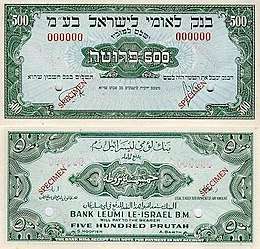 |
500 prutah (I£1/2) | 148 × 72 mm | Olive-green on light-blue | The denomination in centre and above "Bank Leumi le-Israel B.M." all in Hebrew; all surrouned by guilloches. | The denomination and "Bank Leumi le-Israel B.M." all in Arabic and English; all surrouned by guilloches. | 9 June 1952 | 7 February 1961 |
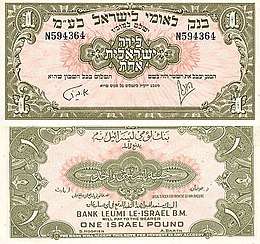 |
1 Israeli pound (I£1) | 150 × 75 mm | Green-pink | ||||
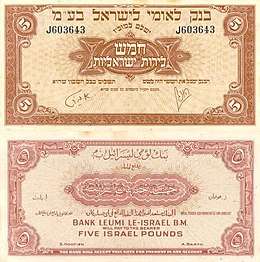 |
5 Israeli pounds (I£5) | 155 × 80 mm | Red-brown | ||||
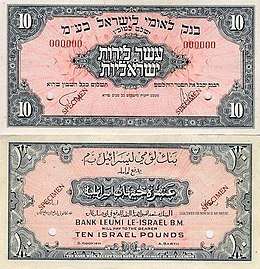 |
10 Israeli pounds (I£10) | 155 × 80 mm | Gray-pink | ||||
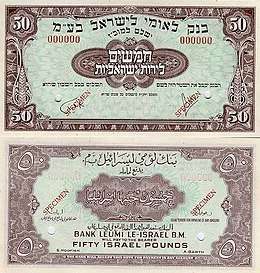 |
50 Israeli pounds (I£10) | 160 × 85 mm | Brown-green | ||||
First Series of the Pound (1955)
| Image | Value | Dimensions | Main Colour | Description | Date of | |||
|---|---|---|---|---|---|---|---|---|
| Observe | Reverse | Watermark | issue | ceased to be legal tender | ||||
 |
500 pruta (I£1/2) | 130 × 72 mm | Red | Ruins of an ancient synagogue at Bir'am in the Upper Galilee. | An abstract design. | Menorah with an imprint of cyclamen. | 4 August 1955 | 31 March 1984 |
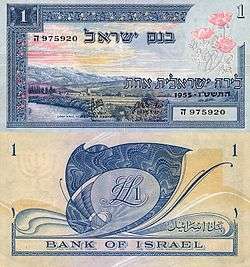 |
1 Israeli pound (I£1) | 135 × 72 mm | Blue | View of the Upper Galilee. | Menorah with an imprint of anemones. | 27 October 1955 | ||
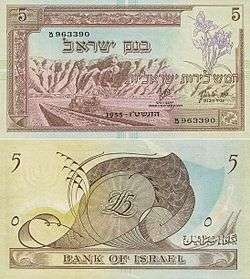 |
5 Israeli pounds (I£5) | 140 × 78 mm | Brown | Negev landscape with a settlement and farm equipment. | Menorah with an imprint of irises. | |||
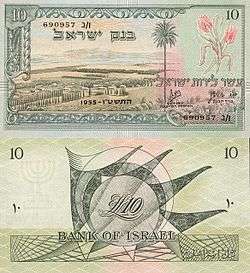 |
10 Israeli pounds (I£10) | 150 × 82 mm | Green | View of the Jezreel Valley depicting settlements and cultivated fields. | Menorah with an imprint of tulips. | 4 August 1955 | ||
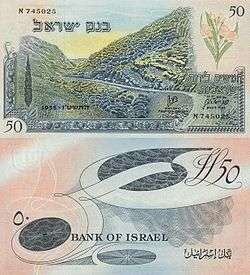 |
50 Israeli pounds (I£50) | 160 × 87 mm | Blue | The road to Jerusalem. | Menorah with an imprint of oleander. | 19 September 1957 | ||
Second Series of the Pound (1959)
| Image | Value | Dimensions | Main Colour | Description | Date of | |||
|---|---|---|---|---|---|---|---|---|
| Observe | Reverse | Watermark | issue | ceased to be legal tender | ||||
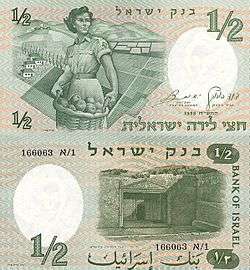 |
1/2 Israeli pound (I£1/2) | 130 × 70 mm | Green | Pioneer-woman soldier holding a basket of oranges against a background of fields. | Tomb of the Sanhedrin in Jerusalem. | The profile of the woman. | 15 October 1959 | 31 March 1984 |
 |
1 Israeli pound (I£1) | 135 × 75 mm | Blue | Fisherman carrying fishing gear against a background of a bay. | Mosaic from the floor of an ancient synagogue at lssafiya on Mt. Carmel. | The profile of the fisherman. | ||
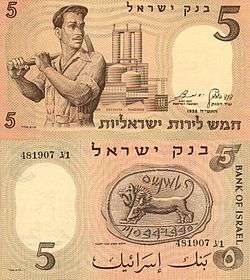 |
5 Israeli pounds (I£5) | 140 × 78 mm | Brown | Labourer holding a sledge-hammer against a background of an industrial plant. | Roaring lion depicted on an ancient Hebrew seal found at Megiddo. | The profile of the labourer. | ||
 |
10 Israeli pounds (I£10) | 150 × 82 mm | Purple | Scientist in a laboratory. | Passage from the Book of Isaiah and the Dead Sea Scrolls. | The profile of the scientist. | ||
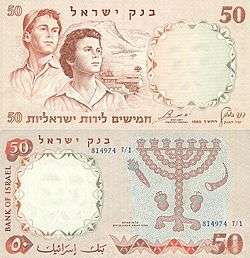 |
50 Israeli pounds (I£50) | 178 × 93 mm | Brown | Two young pioneers against a background of an agricultural settlement in the Negev. | Menorah from the ancient synagogue of Nirim in the Negev. | The profile of the pioneers. | 9 December 1960 | |
Third Series of the Pound (1970)
| Image | Value | Dimensions | Main Colour | Description | Date of | |||
|---|---|---|---|---|---|---|---|---|
| Observe | Reverse | Watermark | issue | ceased to be legal tender | ||||
 |
5 Israeli pounds (I£5) | 150 × 75 mm | Light blue | Portrait of Albert Einstein. | The Atomic reactor at Nahal Sorek. | Profile of Albert Einstein. | 13 January 1972 | 31 March 1984 |
 |
10 Israeli pounds (I£10) | 160 × 82 mm | Yellow-ivory | Portrait of Chaim Nachman Bialik. | Bialik's home in Tel-Aviv. | Profile of Chaim Nachman Bialik. | 6 August 1970 | |
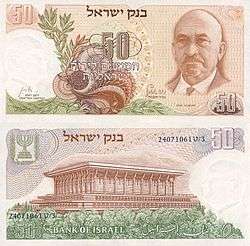 |
50 Israeli pounds (I£50) | 170 × 84 mm | Brown-red | Portrait of Chaim Weizmann. | The Knesset Building in Jerusalem. | Profile of Chaim Weizmann. | 13 January 1972 | |
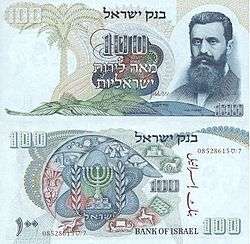 |
100 Israeli pounds (I£100) | 180 × 90 mm | Blue | Portrait of Theodor Herzl. | The Emblem of the State of Israel surrounded by the emblems of the twelve tribes. | Profile of Theodor Herzl. | 27 February 1969 | |
Fourth Series of the Pound (1975)
| Image | Value | Dimensions | Main Colour | Description | Date of | |||
|---|---|---|---|---|---|---|---|---|
| Observe | Reverse | Watermark | issue | ceased to be legal tender | ||||
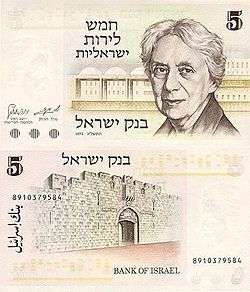 |
5 Israeli pounds (I£5) | 128 × 76 mm | Brown | Portrait of Henrietta Szold; Hadassah Hospital on Mt. Scopus in Jerusalem. | Lion's Gate in the Old City of Jerusalem. | Profile of Henrietta Szold. | 11 March 1976 | 31 March 1984 |
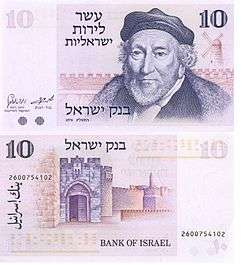 |
10 Israeli pounds (I£10) | 135 × 76 mm | Pink-purple | Portrait of Moshe Montefiori; the Mishkanot Shaananim quarter in Jerusalem with the windmill. | Jaffa Gate in the Old City of Jerusalem. | Profile of Moshe Montefiori. | 30 January 1975 | |
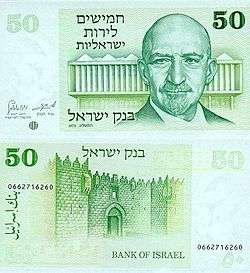 |
50 Israeli pounds (I£50) | 141 × 76 mm | Green | Portrait of Chaim Weizmann; the Wix Library at the Weizmann Institute of Science. | Damascus gate in the Old City of Jerusalem. | Profile of Chaim Weizmann. | 26 January 1978 | |
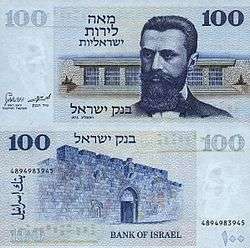 |
100 Israeli pounds (I£100) | 147 × 76 mm | Blue | Portrait of Theodor Herzl; the entrance gate to Mt. Herzl in Jerusalem. | Zion Gate in the Old City of Jerusalem. | Profile of Theodor Herzl. | 14 March 1975 | |
 |
500 Israeli pounds (I£500) | 153 × 76 mm | Ivory-brown | Portrait of David Ben-Gurion; the library at kibbutz Sde Boker. | Golden Gate in the Old City of Jerusalem. | Profile of David Ben-Gurion. | 26 May 1977 | |
Features for the blind
In the third banknote issue, released between 1973 and 1975, a feature was added to assist vision-impaired and blind people in identifying the denomination of a note. A tactile set of dots was used, with three on the five pound note, two on the 10 pound note, one on the 50 pound note, none on the 100 pound note, and a large bar the length of three dots on the 500 pound note.
See also
References
- Krause, Chester L.; Clifford Mishler (1991). Standard Catalog of World Coins: 1801–1991 (18th ed.). Krause Publications. ISBN 0873411501.
- Pick, Albert (1994). Standard Catalog of World Paper Money: General Issues. Colin R. Bruce II and Neil Shafer (editors) (7th ed.). Krause Publications. ISBN 0-87341-207-9.
Footnotes
- ↑ One Palestine Pound, IL: Bank of Israel, archived from the original on April 27, 2006
- ↑ One Israeli Pound, IL: Bank of Israel, archived from the original on 2007-09-27
- ↑ First Series of the Pound, IL: Bank Le-Israel, archived from the original on 2007-09-27
- ↑ One Palestine Pound, IL: Bank of Israel - Anglo Palestine Bank Series
- ↑ One Israeli Pound, IL: Bank of Israel - Le-Israel Series
- ↑ First Series of the Pound, IL: Bank of Israel - First Series of the Pound
External links
| Wikimedia Commons has media related to Israeli Lira. |
